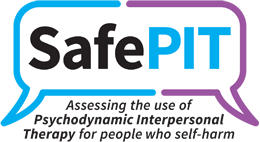For Clinicians
More information About PIT
Psychodynamic Interpersonal Therapy (also called the Conversational Model of Therapy) was developed in the 1970s and draws on both psychodynamic and interpersonal principles, using jargon free language.
The therapy takes the form of an in-depth conversation between two people (client and therapist), in which the client’s difficulties are explored and hopefully resolved. In this sense, PIT sessions bear some resemblance to the kind of “heart to heart” conversation that we might have with a trusted confidante about a personal problem. PIT is more than this, however, because the therapist is trained to help focus the conversation on the most important issues for the client, and support them with any difficult feelings that this brings up.
PIT stems from the fact that people with psychological problems such as self-harm often report problems with managing their feelings, as well as difficulties in their relationships with other people. The PIT conversation therefore focuses on:
- the client’s emotional life including problematic feelings of which they are aware and difficulties they have perhaps pushed to the back of their minds (which is what the term “psychodynamic” refers to);
- the client’s relationships with other people (which is what the term “interpersonal” refers to); and
- how problems with managing feelings and relationships might link with difficult experiences in the client’s past, particularly with their parents or other important people.
The goal of the conversation is for the client to get a better understanding of their difficulties with feelings and relationships, so that they can manage their personal problems more effectively. The expectation is that this will lead to an improvement in their psychological symptoms as well. To do this, the therapist will often encourage the client to focus on and “stay with” difficult feelings that they experience during therapy sessions, so the feelings can be managed in the session, rather than talked about in an intellectual way.
Why PIT for NHS services managing self-harm?
PIT has been evaluated for the treatment of self-harm in a randomized controlled trial of 119 patients who were randomized to 4 sessions of PIT delivered by liaison nurse plus usual care versus treatment as usual alone (Guthrie et al, 2001). There was a reduction in reported self-harm in the six months post-treatment in the patients who received PIT in comparison with the usual treatment group. Approximately 50% of the patients who participated in the trial had a prior history of self-harm.
Following this study, an NHS treatment service, called the SAFE-team was established to deliver PIT to patients who had self –harmed (both repeaters and first episode patients). The service was based in Manchester and ran for over 15 years.
SAFE-PIT is the modified version of PIT that was employed by the service and is specifically tailored for people who SH. There is a focus on the most recent self-harm episode and an attempt to get the client to re-experience his/her feelings at the time of the self-harm behaviour, to stay with those feelings and see what thoughts, images emerge. This process usually leads to a better understanding of the client’s difficulties and an improved ability to manage these difficulties. The process often involves some change in the clients’ relationships. A goodbye letter is given to the client at the end of the therapy to summarise the work and re-enforce positive change.

